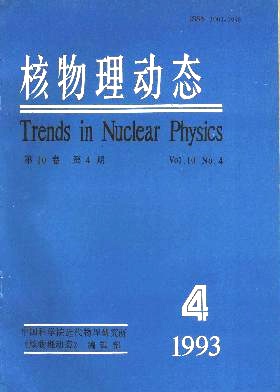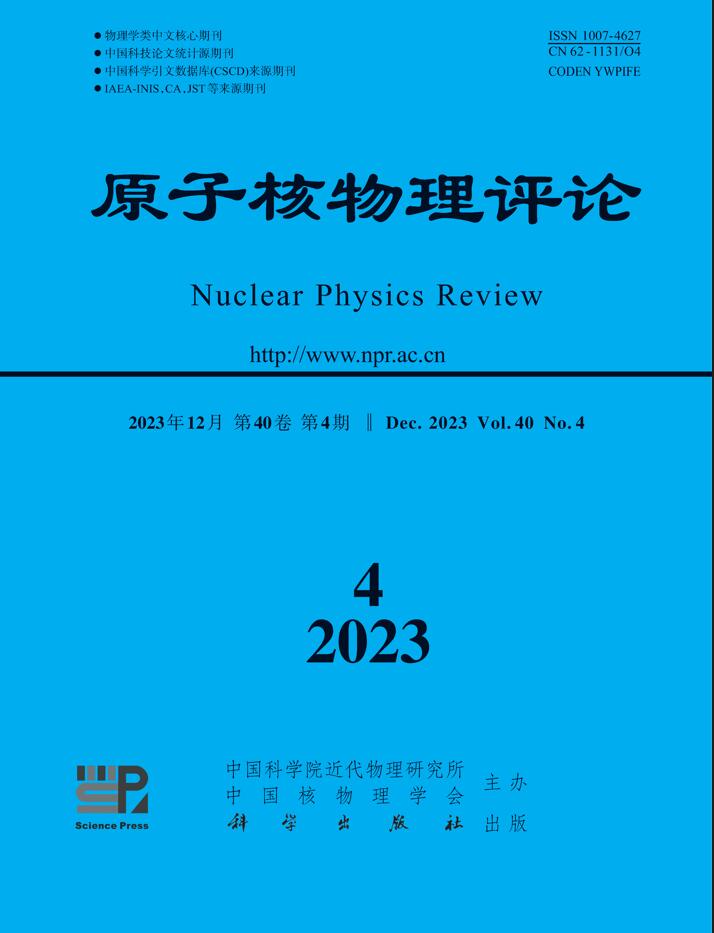1993 Vol. 10, No. 4

Display Method:
1993, 10(4): 1-5.
doi: 10.11804/NuclPhysRev.10.04.001
Abstract:
The most new scientific opportunities of nuclear physics are: the exploration of the quark degrees of freedom and of the underlying theory of the strong interaction, QCD, in the nuclearmedium; the study of the nuclear equation of state and of quark-gluon plasma (QGP); the study ofnuclear structure at the limits of temperature, angular momentum, and neutron-to-proton ratios; theuse of the nuclear medium for precision studies of fundamental aspects of the strong and...
The most new scientific opportunities of nuclear physics are: the exploration of the quark degrees of freedom and of the underlying theory of the strong interaction, QCD, in the nuclearmedium; the study of the nuclear equation of state and of quark-gluon plasma (QGP); the study ofnuclear structure at the limits of temperature, angular momentum, and neutron-to-proton ratios; theuse of the nuclear medium for precision studies of fundamental aspects of the strong and...
1993, 10(4): 6-10.
doi: 10.11804/NuclPhysRev.10.04.006
Abstract:
We introduce the quark delocalization and color screening into the usual quark modeland the property of nuclear force. The resulting N-N phase shifts and the adiabatic potential aredescribed qualitatively well: there are exclusion core and also intermediate range attraction, but thereis no Van der Waals force. The delocalization parameter obtained from variational method is alsoreasonable. we consider especially the effect of mass center motion, the effect of forms of colorscreening...
We introduce the quark delocalization and color screening into the usual quark modeland the property of nuclear force. The resulting N-N phase shifts and the adiabatic potential aredescribed qualitatively well: there are exclusion core and also intermediate range attraction, but thereis no Van der Waals force. The delocalization parameter obtained from variational method is alsoreasonable. we consider especially the effect of mass center motion, the effect of forms of colorscreening...
1993, 10(4): 11-15.
doi: 10.11804/NuclPhysRev.10.04.011
Abstract:
Both atomic clusters (microclusters) and nuclei are systems of the finite number ofparticles but with different interaction forces among the component particles, and have somesimilarities in their properties, such as saturation, shell structures, magic numbers, isotopic effect,deformation and compound clusters (nuclear) process, etc. The similarities rivet attention in manyscientific communities from nuclear, atomic and molecular, and condensed matter physics as well aschemistry.
Both atomic clusters (microclusters) and nuclei are systems of the finite number ofparticles but with different interaction forces among the component particles, and have somesimilarities in their properties, such as saturation, shell structures, magic numbers, isotopic effect,deformation and compound clusters (nuclear) process, etc. The similarities rivet attention in manyscientific communities from nuclear, atomic and molecular, and condensed matter physics as well aschemistry.
1993, 10(4): 16-20.
doi: 10.11804/NuclPhysRev.10.04.016
Abstract:
Both cluster models and unified models, describing in a unified manner alpha decay,cluster decay and spontaneous fission, are briefly introduced. The developments and problems ofnuclear decay models are also described.
Both cluster models and unified models, describing in a unified manner alpha decay,cluster decay and spontaneous fission, are briefly introduced. The developments and problems ofnuclear decay models are also described.
1993, 10(4): 21-24.
doi: 10.11804/NuclPhysRev.10.04.021
Abstract:
The systemaic characters of (n,t) reaction cross sections have been studied for mediumand heavy mass nuclei at 14 MeV. A set of the empirical formulas have been given on the bases of theodd-even effects. The (n,t) reaction cross sections of some nuclei have been calculated, and a goodagreement with the experimental data have been obtained. The Q-value effect and possible reactionmechanism are also discussed.
The systemaic characters of (n,t) reaction cross sections have been studied for mediumand heavy mass nuclei at 14 MeV. A set of the empirical formulas have been given on the bases of theodd-even effects. The (n,t) reaction cross sections of some nuclei have been calculated, and a goodagreement with the experimental data have been obtained. The Q-value effect and possible reactionmechanism are also discussed.
1993, 10(4): 25-29.
doi: 10.11804/NuclPhysRev.10.04.025
Abstract:
The principle and the present situation as well as the prospects corresponded to thephysics of RI beams are described.
The principle and the present situation as well as the prospects corresponded to thephysics of RI beams are described.
1993, 10(4): 30-34.
doi: 10.11804/NuclPhysRev.10.04.030
Abstract:
The construction, particle identification principle and energy calibration method of new generation multidetector are described. In the particle identification, three methods are presented:phoswich fast-slow composition, ΔE-E telescope and CsI fast-slow identification matrix.
The construction, particle identification principle and energy calibration method of new generation multidetector are described. In the particle identification, three methods are presented:phoswich fast-slow composition, ΔE-E telescope and CsI fast-slow identification matrix.
1993, 10(4): 35-38.
doi: 10.11804/NuclPhysRev.10.04.035
Abstract:
The research status of nuclear agronomy in our country and its development in othercountries are summaried in this paper. The results obtained in nuclear agronomy and its prospect arealso introduced.
The research status of nuclear agronomy in our country and its development in othercountries are summaried in this paper. The results obtained in nuclear agronomy and its prospect arealso introduced.
1993, 10(4): 39-42.
doi: 10.11804/NuclPhysRev.10.04.039
Abstract:
A versatile low energy ion facility and its main specifications are described. Some newion beam applications and experimental results are given.
A versatile low energy ion facility and its main specifications are described. Some newion beam applications and experimental results are given.
1993, 10(4): 43-46.
doi: 10.11804/NuclPhysRev.10.04.043
Abstract:
The working principle of scintillating fibers is briefly introduced in this paper. Thedecay time constant and spectral properties of the scintillating fibers of Tb_2O_3 and Ce_2O_3 glass aregiven. Comparing the properties of materials above and CeF_3 with those of other inorganic scintillatingmaterials, we find that CeF_3 and scintillating fibers of the Ce_2O_3 have an immense potential applicationmarket.
The working principle of scintillating fibers is briefly introduced in this paper. Thedecay time constant and spectral properties of the scintillating fibers of Tb_2O_3 and Ce_2O_3 glass aregiven. Comparing the properties of materials above and CeF_3 with those of other inorganic scintillatingmaterials, we find that CeF_3 and scintillating fibers of the Ce_2O_3 have an immense potential applicationmarket.
1993, 10(4): 47-49.
doi: 10.11804/NuclPhysRev.10.04.047
Abstract:
The implantation by using high power pulsed ion beams is a new way of metal surfacemodification. The processes and some experimental results of the implantation by using high power.
The implantation by using high power pulsed ion beams is a new way of metal surfacemodification. The processes and some experimental results of the implantation by using high power.
1993, 10(4): 50-53.
doi: 10.11804/NuclPhysRev.10.04.050
Abstract:
The basic design for Qinshan Nuclear Project Ⅱ is briefly introduced, which mainlyanalyzes the project site and the design for NSSS, special engineered safety, nuclear auxiliray system,annex systems, conventional island, Instrument and Control systems, power supply and distributionsystems and arrangement for buildings. The general design principle and technical features aresummarized in this paper.
The basic design for Qinshan Nuclear Project Ⅱ is briefly introduced, which mainlyanalyzes the project site and the design for NSSS, special engineered safety, nuclear auxiliray system,annex systems, conventional island, Instrument and Control systems, power supply and distributionsystems and arrangement for buildings. The general design principle and technical features aresummarized in this paper.







 甘公网安备 62010202000723号
甘公网安备 62010202000723号